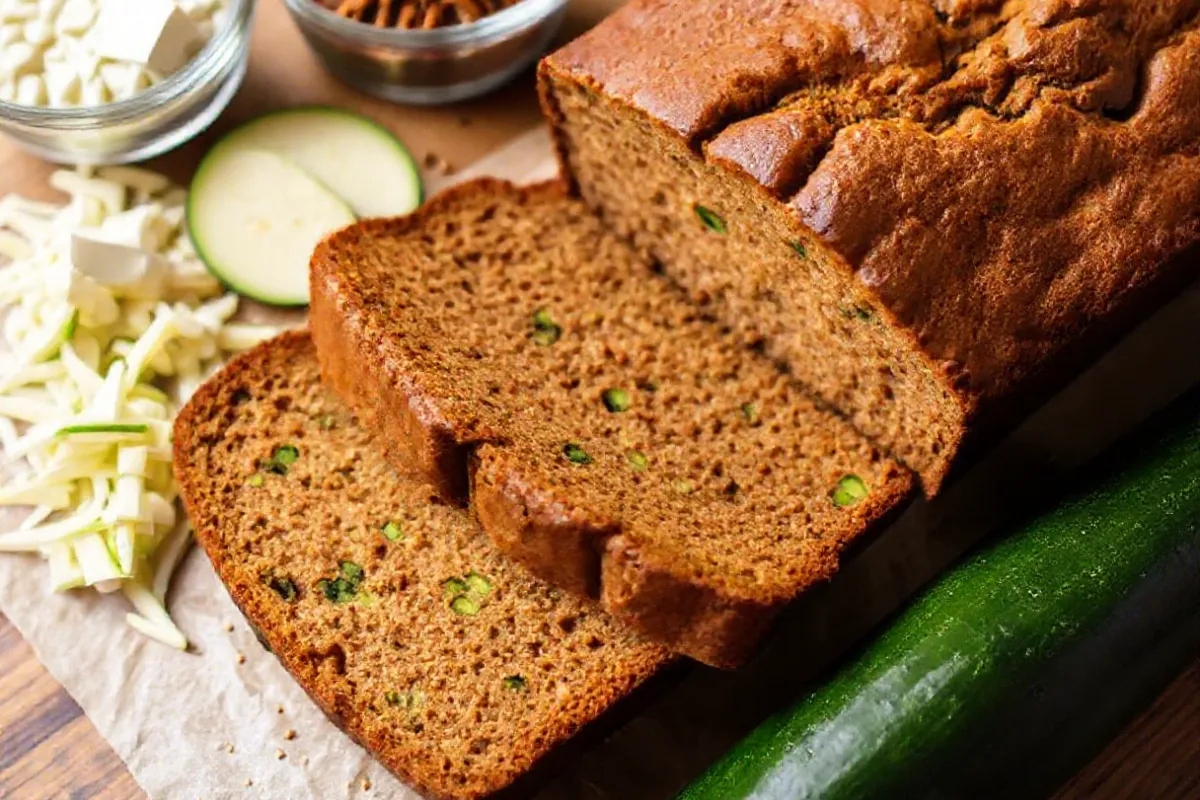Zucchini bread has long been a favorite in the world of quick breads, offering a delicious way to use up summer squash and add some extra vegetables to your diet. However, for those who need to follow a gluten-free diet, finding the perfect recipe for gluten-free zucchini bread can be a bit of a challenge. The good news is that with the right ingredients and techniques, you can create a loaf that is just as moist, flavorful, and satisfying as its gluten-filled counterpart.
If you’re new to gluten-free baking, or if you’re simply looking for a foolproof recipe to add to your collection, this guide will walk you through everything you need to know about making the best gluten-free zucchini bread. You’ll learn about the benefits of zucchini in baking, the importance of choosing the right gluten-free ingredients, and tips for avoiding common pitfalls. Let’s get started!
For a tried-and-true recipe, check out this Easy and Moist Gluten-Free Zucchini Bread that consistently delivers delicious results.
Introduction to Gluten-Free Zucchini Bread
Gluten-free zucchini bread has become increasingly popular, not just among those with celiac disease or gluten sensitivity, but also among health-conscious bakers looking to reduce their gluten intake. Zucchini, with its high water content and mild flavor, is the perfect addition to gluten-free baked goods. It adds moisture and texture, ensuring that the final product is never dry or crumbly.
But why go gluten-free? Gluten is a protein found in wheat, barley, and rye, and while it helps give traditional bread its structure, it can cause serious health issues for those with celiac disease or gluten intolerance. Thankfully, with the growing availability of gluten-free flours and baking products, it’s easier than ever to create delicious baked goods that everyone can enjoy.
You can also explore various recipes at The Best Gluten-Free Zucchini Bread, which offers insights into perfecting this delightful loaf.
The Health Benefits of Gluten-Free Baking
Understanding Gluten and Why Some Avoid It
Gluten-free baking isn’t just for those with celiac disease. Many people have turned to a gluten-free diet for various health reasons, including managing gluten sensitivity, reducing inflammation, and improving digestive health. Gluten can be difficult for some people to digest, leading to symptoms like bloating, headaches, and fatigue. By removing gluten from your diet, you may experience better overall well-being.
The Benefits of Gluten-Free Flours
Gluten-free flours, such as almond flour, coconut flour, and rice flour, offer a range of nutritional benefits that traditional wheat flour doesn’t provide. For instance:
- Almond flour is rich in protein, healthy fats, and vitamin E, which supports skin health.
- Coconut flour is high in fiber, which aids digestion and helps regulate blood sugar levels.
- Rice flour is a good source of manganese, essential for bone health and metabolism.
Using these flours in your gluten-free zucchini bread can not only make it suitable for a gluten-free diet but also boost its nutritional profile.
Zucchini: A Nutrient-Rich Addition
Zucchini is an incredibly versatile vegetable that’s low in calories but high in essential nutrients like vitamin C, potassium, and antioxidants. In baking, zucchini adds moisture, reducing the need for excessive fats or oils, and contributes a subtle flavor that pairs well with sweet or savory ingredients. It’s also a great way to sneak extra vegetables into your diet, especially for picky eaters.
Choosing the Right Ingredients
Creating the perfect gluten-free zucchini bread starts with selecting the right ingredients. Since gluten provides structure and elasticity in baked goods, finding suitable replacements is crucial.
Gluten-Free Flours
The choice of flour can make or break your gluten-free zucchini bread. Some of the best options include:
- Almond Flour: Provides a moist and slightly dense texture, with a nutty flavor that complements zucchini.
- Coconut Flour: Absorbs a lot of moisture, so it’s often used in combination with other flours to avoid dryness.
- Rice Flour: A versatile and mild-flavored flour that works well as a base in gluten-free baking.
- Oat Flour: Adds a hearty texture and is naturally gluten-free if made from certified gluten-free oats.
Using a blend of these flours often yields the best results, balancing moisture, texture, and flavor.
Binders and Leaveners
In the absence of gluten, it’s important to include binders that help hold the bread together and leaveners that give it rise:
- Xanthan Gum: A common binder in gluten-free baking that helps replicate the elasticity of gluten.
- Psyllium Husk: Adds fiber and helps create a structure similar to gluten, improving the texture.
- Baking Powder: Provides the necessary lift, ensuring your zucchini bread isn’t too dense.
Sweeteners and Add-Ins
While zucchini bread is often slightly sweet, the choice of sweetener can greatly affect the flavor and health benefits:
- Natural Sweeteners: Honey, maple syrup, or coconut sugar are great alternatives to refined sugar.
- Add-Ins: Consider incorporating nuts (like walnuts or pecans), chocolate chips, or dried fruit to add texture and flavor.
Step-by-Step Recipe for Gluten-Free Zucchini Bread
Ready to bake? Here’s a comprehensive guide to making the perfect gluten-free zucchini bread.
Ingredients List
- 1 ½ cups gluten-free flour blend (a mix of almond, rice, and oat flour works well)
- 1 teaspoon baking powder
- ½ teaspoon baking soda
- ½ teaspoon xanthan gum (if not included in your flour blend)
- ½ teaspoon cinnamon
- ¼ teaspoon nutmeg
- ¼ teaspoon salt
- 2 large eggs
- ½ cup coconut oil (melted)
- ⅓ cup honey or maple syrup
- 1 teaspoon vanilla extract
- 1 ½ cups grated zucchini (drained)
- Optional: ½ cup chopped nuts or chocolate chips
Preparation
- Prepare the Zucchini: Grate the zucchini using a box grater or food processor. Place the grated zucchini in a clean kitchen towel and squeeze out as much excess moisture as possible. This step is crucial to avoid a soggy loaf.
- Preheat the Oven: Preheat your oven to 350°F (175°C) and grease a 9×5-inch loaf pan or line it with parchment paper.
- Mix the Dry Ingredients: In a large bowl, whisk together the gluten-free flour blend, baking powder, baking soda, xanthan gum, cinnamon, nutmeg, and salt.
- Combine the Wet Ingredients: In another bowl, beat the eggs, then add the melted coconut oil, honey (or maple syrup), and vanilla extract. Stir until well combined.
- Mix the Batter: After adding the wet components to the dry ingredients, mix just until incorporated. Stir in the grated zucchini and any additional ingredients (such chocolate chips or nuts) if using.
- Bake: Transfer the batter into the loaf pan that has been ready and use a spatula to level the top. When a toothpick put into the center comes out clean, bake for 50 to 60 minutes.
- Cool: Before slicing, let the bread sit in the pan for 10 minutes before moving it to a wire rack to cool fully.
Cooling and Storing
After the bread cools fully, keep it in an airtight container or wrap it tightly in plastic wrap. Gluten-free zucchini bread can be stored at room temperature for up to three days, or refrigerated for up to a week. For longer storage, consider freezing individual slices, which can be thawed and enjoyed as needed.
Common Mistakes and How to Avoid Them
Even the most experienced bakers can encounter challenges when making gluten-free zucchini bread. Here are some usual mistakes to be aware of and suggestions for avoiding them:
Overmixing the Batter
- Why It’s a Problem: Overmixing can cause the gluten-free flour to break down, leading to a dense, gummy texture.
- Solution: Gently stir the batter until all of the ingredients are incorporated. It’s normal to have a few little lumps.
Incorrect Measurements
- Why It’s a Problem: Gluten-free baking is less forgiving than traditional baking, and even small measurement errors can lead to undesirable results.
- Solution: Use a kitchen scale to measure ingredients by weight, which is more accurate than measuring by volume.
Not Draining Zucchini Properly
- Why It’s a Problem: Zucchini contains a lot of water, which can make the bread too moist and soggy if not properly drained.
- Solution: After grating the zucchini, squeeze out as much liquid as possible using a clean kitchen towel or cheesecloth.
Flavor Variations and Add-Ins
The versatility of zucchini bread is one of its best qualities. Here are some delicious variations and add-ins to customize your gluten-free zucchini bread:
Chocolate Chip Zucchini Bread
- What You’ll Need: Add ½ cup of dark chocolate chips to the batter.
- Result: A slightly sweeter loaf with pockets of melted chocolate in every bite.
Nutty Zucchini Bread
- What You’ll Need: Add ½ cup of chopped walnuts or pecans to the batter.
- Result: A crunchy texture and nutty flavor that pairs beautifully with the moist zucchini bread.
Savory Zucchini Bread
- What You’ll Need: Reduce the sweetener by half and add 1 teaspoon of dried rosemary or thyme. You can also add ¼ cup of grated Parmesan cheese for a savory kick.
- Result: A more savory version of zucchini bread that can be served as a side dish with soups or salads.
Vegan Gluten-Free Zucchini Bread
- What You’ll Need: Replace the eggs with a flaxseed egg (1 tablespoon flaxseed meal mixed with 3 tablespoons water) and use maple syrup or agave nectar instead of honey.
- Result: A vegan-friendly version that’s just as moist and flavorful as the original.
Adapting the Recipe for Dietary Needs
Zucchini bread is highly adaptable, making it easy to modify the recipe to meet various dietary restrictions. Here are some tips for making the bread even more inclusive:
Dairy-Free Options
- Substitute Ingredients: Use coconut oil or olive oil instead of butter. If the recipe calls for milk, replace it with almond milk, coconut milk, or another plant-based alternative.
- Result: A dairy-free version that’s rich and moist without any compromise in flavor.
Low-Sugar or Sugar-Free Options
- Substitute Ingredients: Replace the honey or maple syrup with a sugar substitute like monk fruit sweetener or stevia. You can also reduce the sweetener by half if you prefer a less sweet bread.
- Result: A lower-sugar option that’s still delicious and perfect for those watching their sugar intake.
Nut-Free Variations
- Substitute Ingredients: Use sunflower seed flour or tiger nut flour as a nut-free alternative to almond flour. Ensure all add-ins are free from nuts.
- Result: A nut-free version that’s safe for those with nut allergies but still retains a
- great texture and flavor.

Frequently Asked Questions (FAQs)
Can I freeze gluten-free zucchini bread?
The bread can be frozen for a maximum of three months. Just let a slice come to room temperature or give it a quick reheat in the microwave.
What’s the best gluten-free flour for zucchini bread?
Often, a combination of gluten-free flours produces the best possible results. Almond flour, rice flour, and oat flour work well together to create a moist, tender loaf. If you prefer a nut-free option, you can use a combination of rice flour and tapioca flour.
How do I make my gluten-free zucchini bread more moist?
The key to moist gluten-free zucchini bread is using enough zucchini and oil (like coconut or olive oil) and not overmixing the batter. Additionally, make sure to drain the zucchini properly to avoid excess moisture that can lead to a soggy loaf.
Is it possible to replace the zucchini in this recipe with another vegetable?
Yes, you can substitute other mild-flavored vegetables like grated carrots or yellow squash for zucchini. These vegetables have a similar moisture content and work well in this recipe, although they may slightly alter the flavor and color.
How long does gluten-free zucchini bread stay fresh?
Gluten-free zucchini bread stays fresh at room temperature for up to 3 days if stored in an airtight container. For longer storage, refrigerate the bread for up to a week or freeze it for up to 3 months.
Final Tips for Perfect Gluten-Free Zucchini Bread
Achieving the perfect gluten-free zucchini bread is all about using the right ingredients and following the correct techniques. Here are a few final tips to ensure your loaf is always a success:
- Don’t Skip the Zucchini Prep: Properly draining the zucchini is essential to avoid a soggy loaf. Squeeze out as much moisture as possible before adding it to the batter.
- Use a Kitchen Scale: Accurate measurements are key in gluten-free baking. Weighing your ingredients will help ensure consistency and better results.
- Let It Cool Completely: Gluten-free baked goods can be delicate, so let the bread cool completely before slicing. This helps the loaf set and makes it easier to cut without crumbling.
Conclusion
Gluten-free zucchini bread is a versatile, delicious, and healthy option for those following a gluten-free diet or anyone looking to enjoy a nutritious treat. By using the right combination of gluten-free flours, sweeteners, and add-ins, you can create a loaf that’s just as moist and flavorful as traditional zucchini bread.
Whether you prefer a classic recipe, a nutty variation, or a savory twist, this guide provides you with all the information you need to bake the perfect gluten-free zucchini bread. So gather your ingredients, preheat your oven, and enjoy the process of making this delightful bread at home. Not only will you have a delicious treat to enjoy, but you’ll also be contributing to a healthier lifestyle with every slice.
For additional tips and variations, don’t forget to check out Gluten-Free Zucchini Bread Recipe, which offers more insights into customizing this classic loaf.





